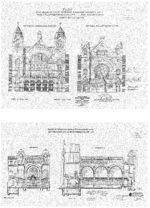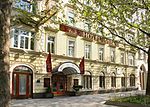Theater in der Leopoldstadt

The Theater in der Leopoldstadt (also: Leopoldstädter Theater) was an opera house in the Leopoldstadt district of Vienna, founded in 1781 by Karl von Marinelli, following the Schauspielfreiheit (ending of the court's monopoly on entertainment) by Joseph II in 1776. The 19th-century summer stage called the Thaliatheater was also managed by the Leopoldstadt. In its early years, the theatre staged Singspiele and Possen mit Gesang, notably by the theatre's Kapellmeister Wenzel Müller and his assistant Ferdinand Kauer. The dramatist Ferdinand Raimund worked with the theatre in the 1820s. The theatre was eventually demolished and rebuilt in 1847, under the name of the Carltheater.
Excerpt from the Wikipedia article Theater in der Leopoldstadt (License: CC BY-SA 3.0, Authors, Images).Theater in der Leopoldstadt
Praterstraße, Vienna KG Leopoldstadt (Leopoldstadt)
Geographical coordinates (GPS) Address Nearby Places Show on map
Geographical coordinates (GPS)
| Latitude | Longitude |
|---|---|
| N 48.215 ° | E 16.3844444444 ° |
Address
Praterstraße 33
1020 Vienna, KG Leopoldstadt (Leopoldstadt)
Austria
Open on Google Maps











